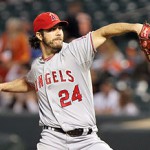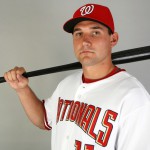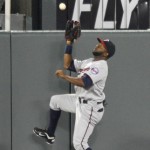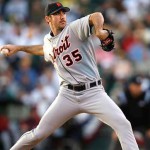Mark Zuckerman posted a nice little Wins Above Replacement (WAR) analysis article in the wake of the Gio Gonzalez signing back in December 2011, showing that without any further moves and with the expected projections of WAR improvement the 2012 Nats should improve by nearly 12 wins if our injured stars return to the norm and produce as expected. As it turned out, he was right … and wasn’t “right” enough. He actually under-valued the WAR contributions of a newly healthy Adam LaRoche and of what Gonzalez would give the team (and of course nobody could have predicted what Ian Desmond would do nor how big an impact Bryce Harper would have) and the Nats ended up improving 17 games instead of a predicted 12 from 2011’s 81-81 team.
Here’s a similar analysis for your 2013 Nats, with some thoughts on players who may improve or regress from their 2012 WAR totals, and then using that analysis to predict how the team may fare in 2013. I have uploaded my working 2013 fWAR spreadsheet to docs.google.com (also a link on the right-hand side of the page), which is the basis of the cut-n-paste tables below. For the purpose of this article, we’re assuming that LaRoche is leaving and Michael Morse is playing 1B full-time, that Bill Bray is making the bullpen, and that Christian Garcia is starting in AAA.
A quick note before starting: the two leading baseball stats sites both have their own versions of the Wins Above Replacement stat. Baseball-Reference’s WAR (usually abbreviated bWAR or rWAR) was developed by Sean Smith at BaseballProjection.com. Meanwhile, fangraphs.com has developed their own version of WAR (usually abbreviated fWAR to distinguish from the Baseball-Reference version). A good analysis of the differences between the two WARs is here: the main differences relate to the use of FIP versus ERA and TotalZone versus UZR for defensive additions. In this article i’m using solely fWAR. I think fWAR is slightly better and uses better component parts, though honestly the difference between the two is often negligible.
How many wins would an entire team of replacement level players win? In other words, where do you start adding WAR figures to, in order to estimate how many wins you should expect out of your team? Jim Breem of the Milwaukee-Wisconsin Journal Sentinel did just this study in Jan 2011 and discovered that the average of replacement level wins across MLB in 2010 was 45.5 wins. In other words, you could expect a team of nothing but AAA-level veterans or 0.0 WAR players to win about 45-46 games in a season. This is about on par with the figure’s I’ve heard in various chats, and is somewhat supported by last year’s awful Houston Astros (who finished 55-107 and had just a handful of players posting a 1.0 WAR or greater). The 2012 Nats fWAR totaled exactly 50.0, the team finished 98-64 and they had a Pythagorean record of 96-66, implying that a team of replacement Nats players would win between 46 and 48 games, right in line with Breem’s studies. For the purposes of predicting the # of 2013 Nats wins we’ll use 46 as a floor.
How did our returning players fare in 2012, and what might they contribute in 2013? Here’s my estimates for all returning players. This table is sorted by 2012 fWAR from highest to lowest. (b) after a pitcher’s name indicates the fWAR contributions (or lack thereof) of that pitcher at the plate.
| 2012 fWAR | 2013 fWAR Est | Trend from 2012 | |
| Ian Desmond | 5.4 | 5 | Down |
| Gio Gonzalez | 5.4 | 4.8 | Down |
| Bryce Harper | 4.9 | 6 | Up |
| Ryan Zimmerman | 4.5 | 5 | Up |
| Stephen Strasburg | 4.3 | 5 | Up |
| Danny Espinosa | 3.8 | 3.8 | Even |
| Jordan Zimmermann | 3.5 | 4 | Up |
| Roger Bernadina | 1.9 | 2 | Even |
| Ross Detwiler | 1.8 | 2 | Even |
| Jayson Werth | 1 | 1.5 | Up |
| Tyler Clippard | 1 | 1 | Even |
| Steve Lombardozzi | 0.8 | 0.8 | Even |
| Craig Stammen | 0.8 | 0.8 | Even |
| Stephen Strasburg (b) | 0.7 | 0.8 | Even |
| Drew Storen | 0.7 | 1 | Up |
| Tyler Moore | 0.6 | 0.6 | Even |
| Wilson Ramos | 0.6 | 0.2 | Down |
| Kurt Suzuki | 0.6 | 1.5 | Up |
| Chad Tracy | 0.5 | 0.5 | Even |
| Jhonatan Solano | 0.4 | 0 | Down |
| Jordan Zimmermann (b) | 0.4 | 0.4 | Even |
| Michael Morse | 0.3 | 3 | Up |
| Zach Duke | 0.2 | 0.8 | up |
| Corey Brown | 0.1 | 0 | Even |
| Eury Perez | 0.1 | 0 | Even |
| Christian Garcia | 0.1 | 0 | Even |
| Sandy Leon | 0 | 0 | Even |
| Ryan Mattheus (b) | 0 | 0 | Even |
| Zach Duke (b) | 0 | 0 | Even |
| Craig Stammen (b) | -0.1 | 0 | Even |
| Carlos Maldonado | -0.1 | 0 | Even |
| Ryan Perry | -0.2 | 0 | Even |
| Ryan Mattheus | -0.2 | -0.2 | Even |
| Gio Gonzalez (b) | -0.3 | -0.3 | Even |
| Henry Rodriguez | -0.4 | -0.4 | Even |
| Ross Detwiler (b) | -0.5 | -0.6 | Even |
Here’s some discussion on my estimates:
Players who I’m trending Up: Harper, Zimmerman, Strasburg, Werth, Suzuki, Storen, Zimmermann, Morse and Duke. I have Harper going from a 4.9->6.0 fWAR player, which frankly may be selling the kid short. Lots of pundits think he’s going to explode in 2013 for a Mike Trout-like season. I think both Zimmerman and Strasburg can achieve 5.0 fWAR seasons. I think Werth can go from a 1.0->1.5 with a full healthy season, especially if he continues to hit as he did upon returning last year (we’ll ignore for a moment that he’s not “earning” his salary with fWAR seasons in the 5.0 fWAR range like he’s being paid to do). Suzuki has a couple of 3.4 fWAR seasons under his belt; estimating him at 1.5 may be selling him short. Storen returns to the closer role healthy, though an improvement to just 1.0 fWAR would be a career best for him. I’m predicting an improved season out of Zimmermann, who seemed to tire at the end of last season in his first full season back from Tommy John surgery. Morse has a huge increase predicted (from 0.3->3.0) but he posted a higher fWAR than that in his breakout 2011 season; if he’s here and playing full time, there’s no reason to not expect another season like 2011’s. Lastly Duke’s 0.8 fWAR estimate may be exceedingly high, but he managed to add 0.2 fWAR in just a few weeks of work in September.
Players who I’m Trending Down: Desmond, Gonzalez, Ramos and Solano: I think Ramos and Solano’s contributions are now limited and/or blocked by Suzuki, so their fWAR contributions drop accordingly. I’m building in some regression for both Desmond and Gio from last year’s fantastic performances. Most every player with an estimate of 0.0 for 2013 is assumed to be spending the majority of the season in the minors (notably Ryan Perry and Garcia, but also the likes of Corey Brown, Eury Perez and all the backup catchers we had to use last year).
Notable Players who I’m trending about Even: Espinosa, Bernadina, Detwiler, Clippard, Stammen, Henry Rodriguez: Even, meaning they’ll contribute about the same in 2013 that they did in 2012. Is Clippard going to contribute 1.0 fWAR in 2013? Maybe not. Can Stammen repeat his stellar performance? Will Rodriguez continue to drag down the bullpen with a -0.4 fWAR? If anything, Espinosa should improve on his 3.8 fWAR; he’s trending up year over year. I’ve listed almost all our backups (Bernadina, Lombardozzi, Moore, Tracy, etc) as being even year over year; there’s no reason right now not to expect the same performance we got out of them in the coming season. For the moment I’m leaving Garcia in AAA, and have his fWAR at zero; if he were to join the bullpen on a full time basis he could contribute half a WAR or more.
Here’s a quick look at our new players acquired this off-season:
| New Players for 2013 | 2012 fWAR | 2013 fWAR Est | Trend from 2012 |
| Dan Haren | 1.8 | 4.5 | Up |
| Dan Haren (b) | -0.1 | -0.3 | Down |
| Denard Span | 3.9 | 3.9 | Even |
| Bill Bray | -0.6 | 0.3 | Up |
| Bill Bray (b) | 0 | 0 | Even |
Perhaps the most controversial estimate in this article is Haren‘s 2013 fWAR number. I’m estimating that he’s going to return to his previous form and at least post a 4.5 fWAR. If you look at his history before 2012, you’ll see he’s easily capable of posting a 6.0 fWAR or higher. I think the team gave him the contract they did because they’re assuming he’s healthy and assuming he can return at least to his 2011 form. A 4.5 estimate may end up being low. Meanwhile, I’m assuming Span is going to just repeat his 2012 performance, and I’m assuming that Bray improves upon his own poor 2012 and returns to something closer to his 2011 form (where he posted a 0.7 fWAR).
Given the above breakdown, here’s how the summaries look:
| 2012 fWAR | 2013 fWAR Est | ||
| sum of 2012 fWAR of returning players –> | 42.6 | 49 | <– Sum 2013 fWAR estimates existing players |
| sum of 2012 fWAR for departed players –> | 7.4 | ||
| 8.4 | <– Sum 2013 fWAR estimates new Additions | ||
| sum of 2012 fWAR –> | 50.0 | 57.4 | <– Sum 2013 Nats fWAR Estimates |
Ok, what does the above table mean?
- Sum of WAR Returning of 42.6: this is the sum of the fWARs of all pitchers and batters in 2012 who are returning to the team in 2013 (as broken down in the upper table).
- Sum of WAR Gone of 7.4: this is the sum of the fWARs of all pitchers and batters in 2012 who are no longer with the team. Adam LaRoche leads this list with a 3.8 fWAR in 2012, though also included in this list are a number of negative fWAR players who drug the team down last year (DeRosa, Wang and Nady especially).
- Sum of 2012 Nats fWAR of 50.0: This is the sum of returning and departing 2012 players, and is the same number referenced above.
- Sum fWAR estimates of existing players: 49: This is the sum of the fWAR for all our returning players for 2013; notice this is higher; I’m predicting that through attrition of poor players and some improvement over 2012, we can expect our team to be nearly 7 wins improved.
- Sum fWAR new additions: 8.4: Span, Haren and Bray should add 8.4 fWAR (as shown in the second table).
- Sum 2013 Nats fWAR estimates: 57.6
That’s right; I believe the team has an fWAR capability of 57.6, or 7.6 wins more than last year. Adding that to the previously discussed fWAR floor of 46 games and you have a 103-104 win team.
What happens if LaRoche comes back? If anything the team could be improved even more. LaRoche posted a 3.8 fWAR in 2012, while Morse’s BEST fWAR season was his 2011 breakout of 3.3. If we assume LaRoche can repeat his 2012 performance at least for one year into a 2-3 year contract, then the team’s fWAR estimates rise again.
Does this mean I’m predicting that the 2013 Nationals are going to win 104 games? Well, no. Every single one of these estimates implies a 100% best case scenario; no injuries and for the most part all our players playing at their capability levels of 2012. In reality, we’re going to see some time lost due to injury from key players, and we’re going to see some regression from some players. The hope is that those regression periods are matched by improvements from other players, or from breakout performances from players who were in the 1.0 fWAR range in the past (think Desmond in 2012).
One last note on WAR (which I’d love to see others’ opinions about): I admittedly have an uneasy and not always consistent opinion on the statistic. On the one hand, I absolutely believe that career WAR values reward accumulator type players and skew career WAR figures (my favorite example to use is Bert Blyleven, who currently sits with the 39th largest career bWAR in the history of the game. But no one in their right mind would claim that Blyleven was the 39th best player to ever play the game… so there’s a disconnect that I have a difficult time dealing with). But, on the other hand, WAR usually does a nice job of quantifying individual seasons, and lending itself to the kind of analysis I’ve just done here. Do I need to overcome my reservations of using the statistic? How can I reconcile my concerns with the overall prevalence of the stat?






